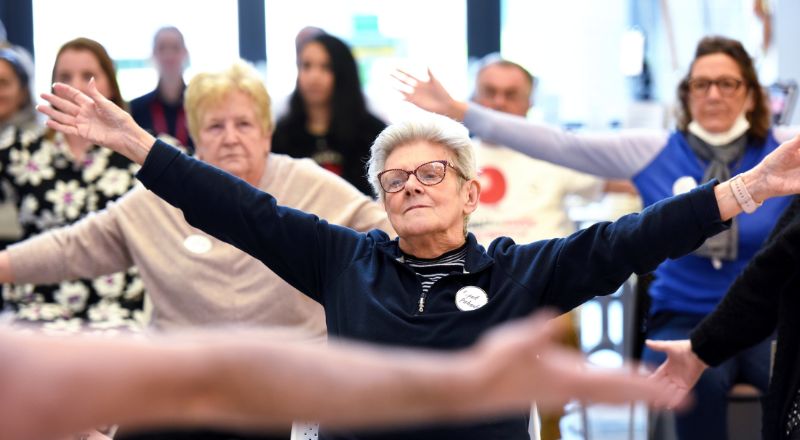Researchers reducing falls risk for people living with chronic disease
Researchers from Teesside University and the National Institute for Health and Care Research (NIHR) Applied Research Collaboration (ARC) North East and North Cumbria (NENC) are exploring how to improve balance and prevent falls in people with Chronic Obstructive Pulmonary Disease (COPD).

More than 1.2m people in the UK live with COPD, which causes breathlessness, coughing and frequent chest infections. People with COPD are four times more likely to fall than healthy adults of the same age due to poor balance. Muscles become weaker and slower to react to unsteadiness with age, but symptoms and inactivity mean this happens more quickly in people with COPD.
Social and environmental factors also contribute to falls, such as how much space someone might have at home or what their daily routine looks like.
Pulmonary rehabilitation is the usual treatment for COPD, including 6 to 8 weeks of exercise and disease education to reduce breathlessness. Balance training is not normally included in this.
Professor Samantha Harrison from Teesside University and the NIHR ARC NENC is leading a £1.1m programme of work, funded by an Advanced Fellowship from the NIHR, to develop balance training for people with COPD.
The research programme, B-Pure, involves NHS trusts from across the Durham and Tees Valley Alliance; academics from Newcastle, Northumbria and Manchester Metropolitan Universities; and members of Breathe Easy Darlington, a support group for people with chronic breathlessness.
Professor Harrison said: “Our interest in investigating balance and falls in people with COPD stems from many conversations with patients who describe falling and becoming unsteady on a daily basis - sharing experiences both in and out of the home, including colliding with door handles, falling down stairs, wobbling when turning to put a key in a lock, and swaying when getting up from a chair.
“We wanted to know if a balance training programme could help with this and therefore help to improve the lives of people living with COPD.”
The project has four main elements:
- Exploring existing research around exercise programmes already delivered to people with COPD and the impact on balance.
- Testing muscle strength, reaction times and balance of people with COPD and older adults without COPD in clinical labs at Teesside University to see if weaker muscles and slower reactions explain why balance is worse in those with COPD.
- Spending time with people in their homes to understand the day-to-day challenges of living with COPD.
- Developing a new balance training programme with patients, carers, healthcare professionals and those interested in physical activity promotion which will be trialled and evaluated to see if and how it helps to prevent falls.
We wanted to know if a balance training programme could help with this and therefore help to improve the lives of people living with COPD.
The work to develop a balance training intervention is ongoing, and an 18-month trial will begin at the end of the year.
The aim is that balance training will be included as a core component of clinical care for individuals with COPD.
Key initial findings have now been published and translated into an engaging storyboard and infographic.
The storyboard was developed with members of the Breathe Easy Darlington group and designed by Dr Rachel Thomas, Senior Lecturer in Comics, Graphic Novels and Sequential Art at Teesside University.
Gill, Chair of Breath Easy Darlington, said: “Our involvement with this project and Teesside University has had a tremendous impact on our group. We have definitely felt the benefit and have not only a brighter outlook but feel a good deal fitter.”
NIHR ARC NENC Research Fellow Dr Sophie Suri is supporting the project. She said: “The infographic really captures the multiple, and often overwhelming, challenges that people living with COPD face daily.
“It is a busy graphic, depicting difficulties both inside and outside of the home, which patients often have little or no control over.
“We hope that this infographic helps to highlight the wider social and environmental factors that have an impact on those living with COPD and help health and care practitioners to see COPD through their patients’ eyes.”
Research Fellow Kirsti Loughran, from Teesside University, is also supporting the study. She added: “Seeing how people interact with their environment and talking to them about it offers a deep understanding of what life really is like with COPD.
“This gives us a better understanding of why going for a walk or exercising at home can be really difficult. We can now use this information to build an intervention that is much more accessible to those who really need it, and that’s very exciting.”
Find more about Initial findings
 New affordable service launched at NHC to accelerate gene
...
New affordable service launched at NHC to accelerate gene
... Researchers reducing falls risk for people living with
...
Researchers reducing falls risk for people living with
... Digital excellence continues to be recognised at Teesside
...
Digital excellence continues to be recognised at Teesside
...